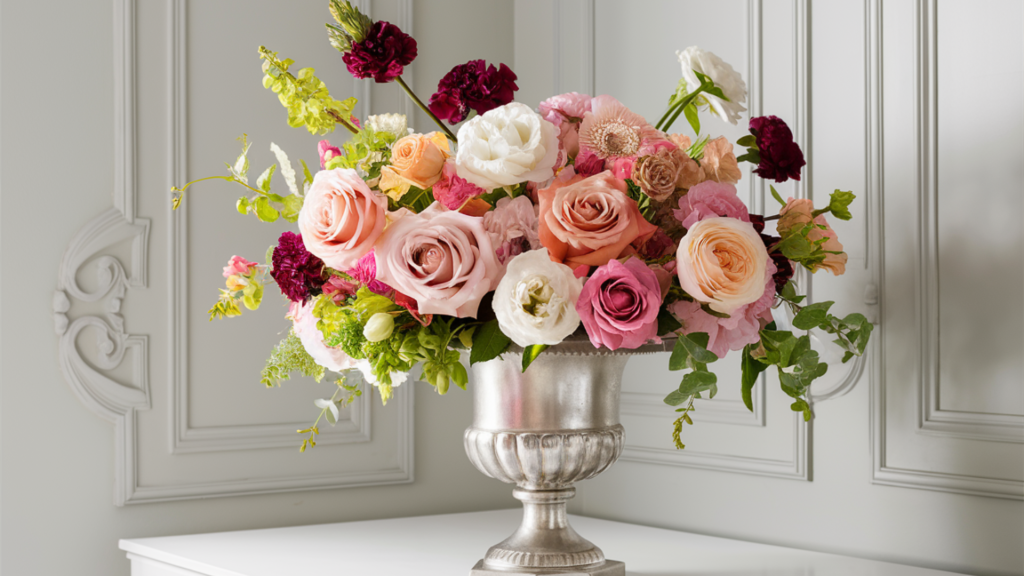A vanishing point is where all lines or stems seem to come together in a drawing or design. It helps create depth and makes things look more real. Artists use it in paintings and sketches to make objects appear farther away or closer. You can also see this idea in floral design, where stems are arranged to lead the eye toward a main focus.
Understanding vanishing points is important for anyone who wants to create balanced and eye-catching designs. Whether you’re sketching a street scene, arranging flowers, or even designing a room, this concept helps guide the viewer’s eye.
In this blog, I’ll explain what a vanishing point is, how it works in art, and why it matters in floral design. By the end, you’ll know how to use this idea to make your creations appear more natural and well-structured.
What is a Vanishing Point?
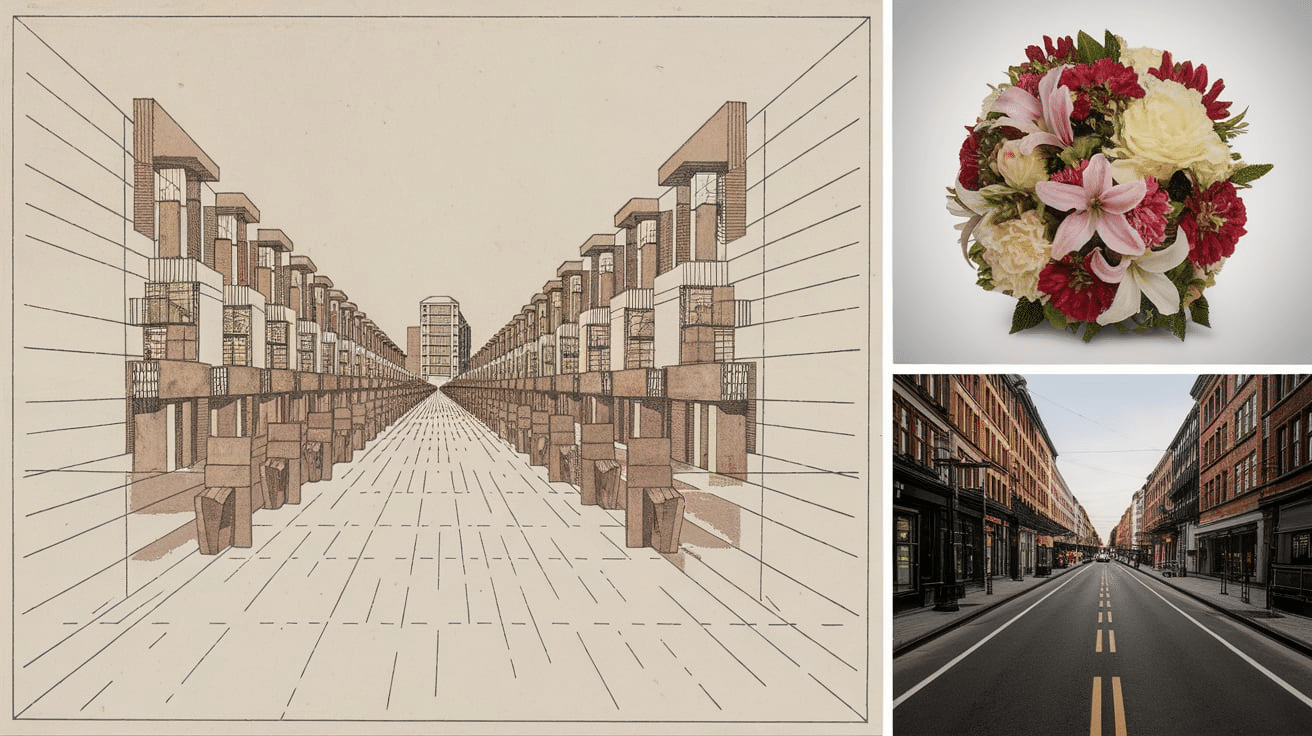
A vanishing point is where all lines seem to come together in a picture, creating the illusion of depth. It’s a basic idea in perspective drawing that helps make flat images look three-dimensional. Artists use vanishing points to make drawings and paintings look more realistic.
By following this rule, they can show how objects get smaller as they move farther away. The most common type is a one-point perspective, where everything lines up toward a single spot on the horizon. This technique is also useful in photography, architecture, and even floral design.
Vanishing Point in Floral Design
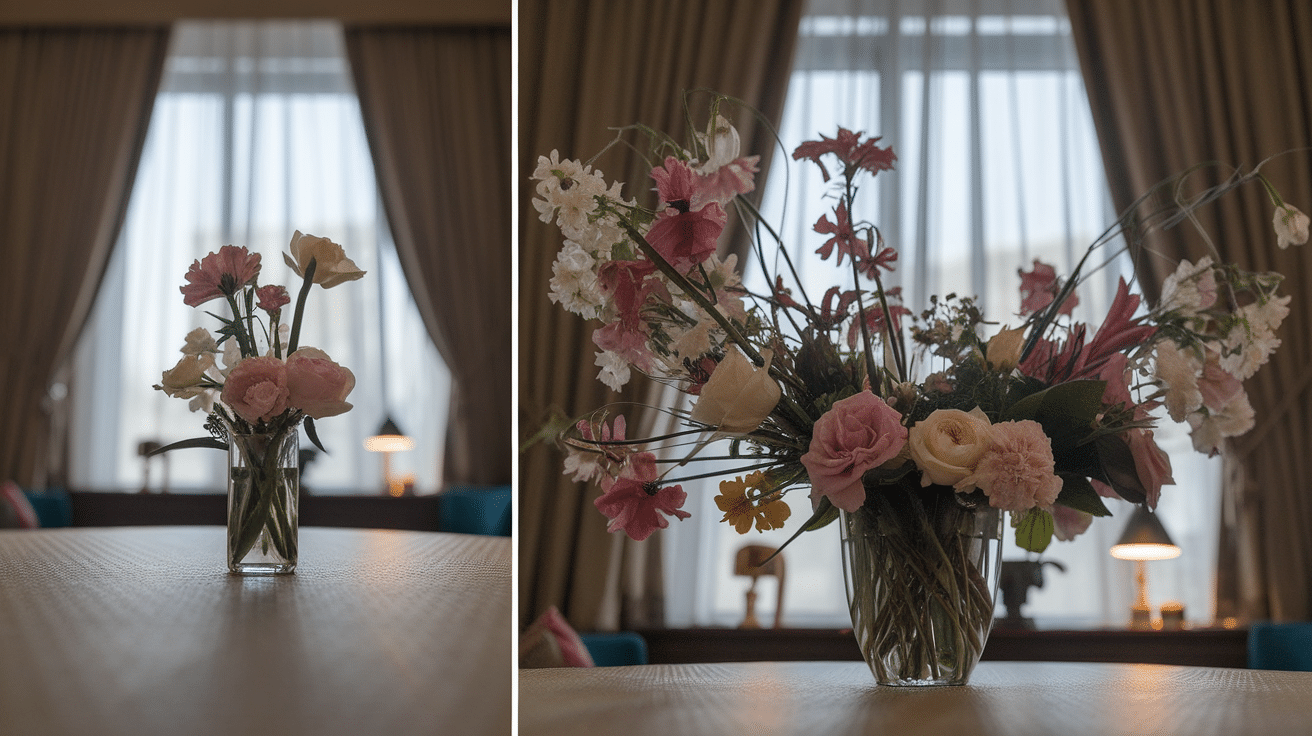
A vanishing point isn’t just for art—it’s also used in floral design. In simple terms, it’s the spot where all the stems seem to come together, creating a sense of balance and direction in an arrangement. Just like in a drawing, this helps guide the eye toward a focal point, making the design look neat and well-planned.
Florists use this idea to make their arrangements more natural and pleasing. When flowers and stems are placed correctly, they lead the viewer’s eye toward the main flower or center of the design. This technique is especially common in bouquets and centerpiece arrangements.
By using a vanishing point, a floral design feels more structured instead of messy. It helps create depth, making the arrangement seem full and dynamic. Whether you’re arranging flowers at home or professionally, keeping this in mind can make a big difference.
Why Is Vanishing Point Important in Floral Design?
A vanishing point isn’t just for drawings—it plays a big role in floral design as well. It helps make flower arrangements look balanced and professional.
1. Creates a Focal Point: A vanishing point leads the eye to the most important flower or area in the arrangement, making it more visually appealing.
2. Adds Depth and Dimension: Instead of looking flat, an arrangement with a vanishing point has depth, making it feel fuller and more natural.
3. Brings Balance and Harmony: When stems and flowers follow a natural flow toward a single point, the design looks more organized and pleasing.
4. Guides the Viewer’s Eye: Just like in a painting, a vanishing point helps direct attention where it’s needed, preventing a cluttered or distracting look.
5. Improves the Overall Shape: Whether in a bouquet or centerpiece, using a vanishing point ensures that flowers are arranged in a way that looks structured and intentional.
By understanding and applying this concept, anyone can create floral arrangements that feel polished and well-designed.
How to Use Vanishing Points in Floral Design
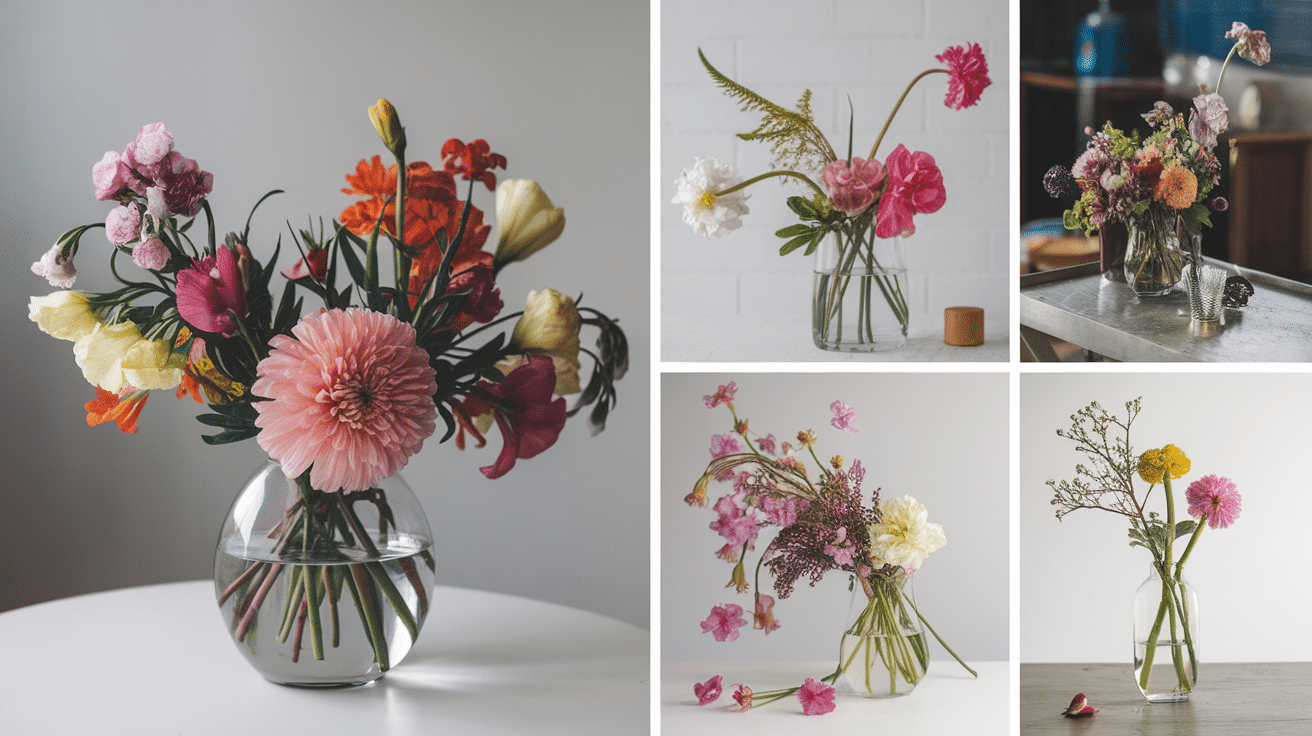
A vanishing point helps bring structure and balance to a floral arrangement. It’s the spot where all the stems seem to come together, creating a natural flow that makes the design appear neat and intentional.
1. Choose a Focal Point
Every great floral arrangement needs a main focus. This could be a large bloom, a bright flower, or an eye-catching feature. A vanishing point helps direct all the elements toward this focal area, making it stand out beautifully. Without a clear focal point, the arrangement may look scattered, making it harder for the eye to settle on one main area of interest.
2. Arrange Stems Toward a Central Side
Imagine an invisible point at the base or center of your arrangement. Place stems so they appear to extend from this point. This gives the design a sense of direction and flow, making it look more put together. When all the stems lead to the same area, the arrangement looks more natural and cohesive rather than messy or unbalanced.
3. Use Different Heights and Angles
Arrangements with a mix of heights look more dynamic and natural. Place taller flowers toward the back or center and shorter flowers around the edges. This technique helps create depth and prevents the arrangement from looking flat. By layering flowers at different heights, you can add dimension and make each bloom more visible.
4. Create a Natural Flow
Flowers should look like they naturally belong together. Instead of forcing stems into stiff or unnatural positions, let them follow their curves while still leading toward the vanishing point. This keeps the design soft, organic, and visually pleasing. When flowers flow naturally, the arrangement feels effortless and balanced, creating a more inviting look.
4. Adjust for Different Styles
The vanishing point technique works with different types of floral arrangements. In symmetrical designs, all flowers should point toward the center, creating a classic, formal look. In asymmetrical designs, stems may lean toward one side while still following an invisible line that guides the eye.
5. Use Spacing Wisely
Overcrowding flowers can make an arrangement look messy. Leaving small gaps between blooms allows each flower to shine while still leading toward the vanishing point. This also makes the design look more natural and airy. Proper spacing helps highlight individual flowers while maintaining a structured and well-balanced composition.
Once you finish arranging, take a step back and view your work from different angles. Does the arrangement naturally guide the eye toward the focal point? Does it feel balanced? If something looks off, small adjustments to spacing or angles can improve the final look.
Using vanishing points in floral design helps create professional-level arrangements with a natural, pleasing flow. Whether for home decor, weddings, or events, this technique makes flowers stand out in the best way possible.
Vanishing Points in Popular Floral Styles
Vanishing points help bring balance and direction to floral arrangements, no matter the style. Different floral designs use vanishing points in unique ways to create structure, depth, and visual appeal. Here’s how vanishing points work in some of the most popular floral styles.
1. Round Arrangements
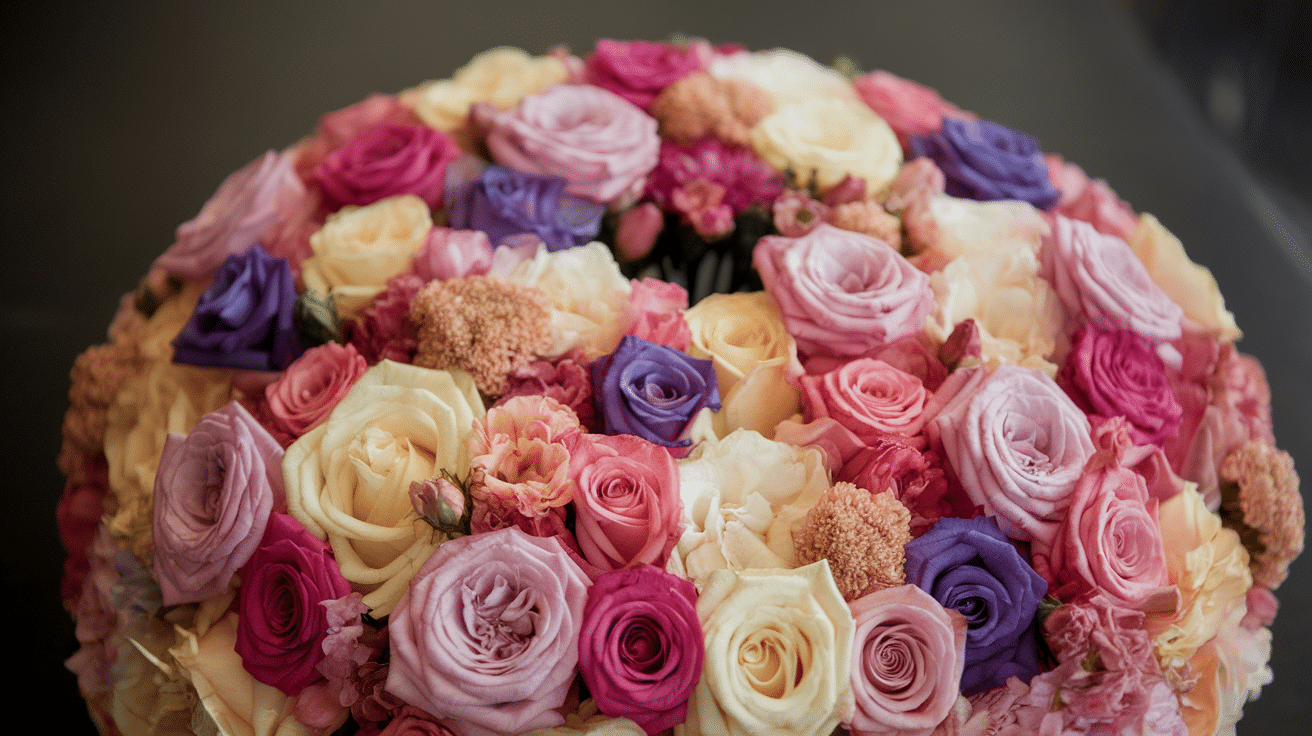
Round floral arrangements, often used for centerpieces or bouquets, have a vanishing point at the center. Stems radiate outward evenly, creating a full, symmetrical look. This style is perfect for weddings, events, and formal settings.
How vanishing points help:
- Keep the design balanced and polished.
- Ensures all flowers lead toward the central focal point.
- It makes the arrangement look structured rather than random.
2. Cascading Arrangements
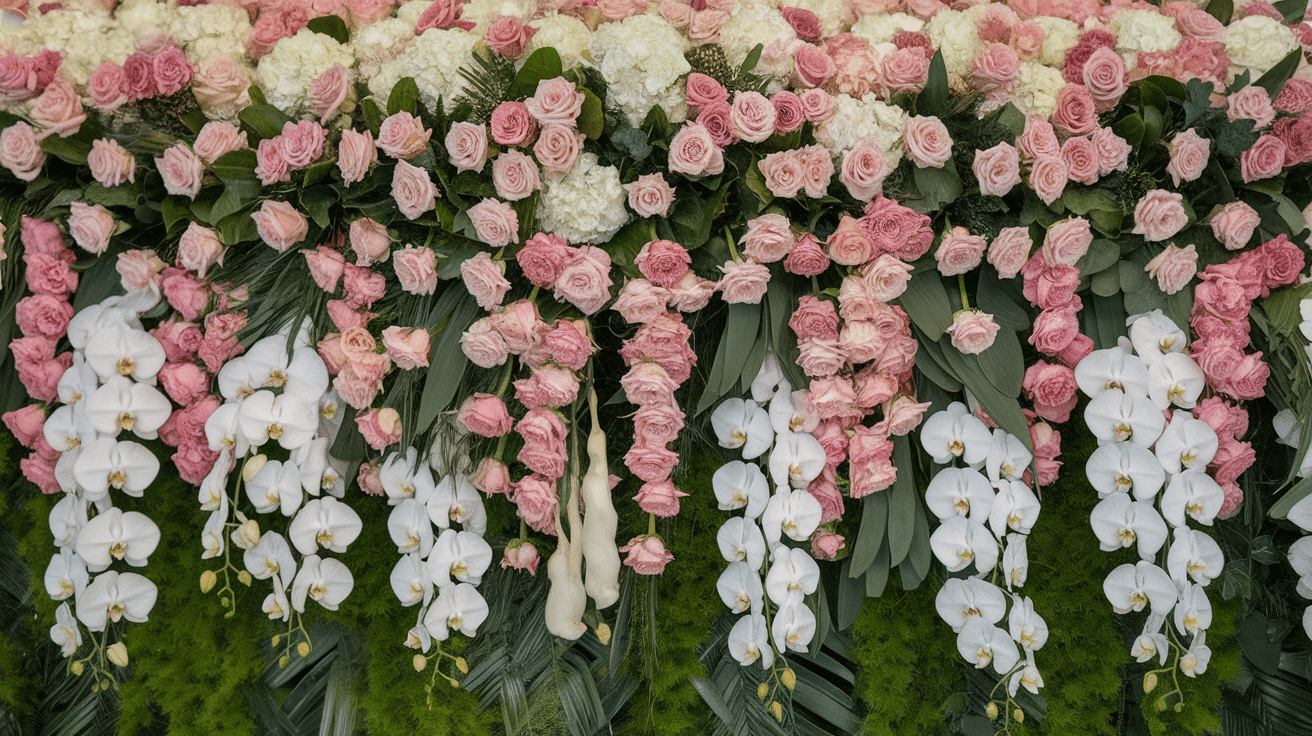
Cascading floral designs have a flowing, waterfall-like effect. The vanishing point is usually at the top, where the flowers start, while the arrangement extends downward in a natural, trailing motion.
How vanishing points help:
- Creates a graceful, flowing look.
- Guides the eye from the focal point down through the design.
- Keeps the cascading effect balanced instead of messy.
3. Horizontal Arrangements
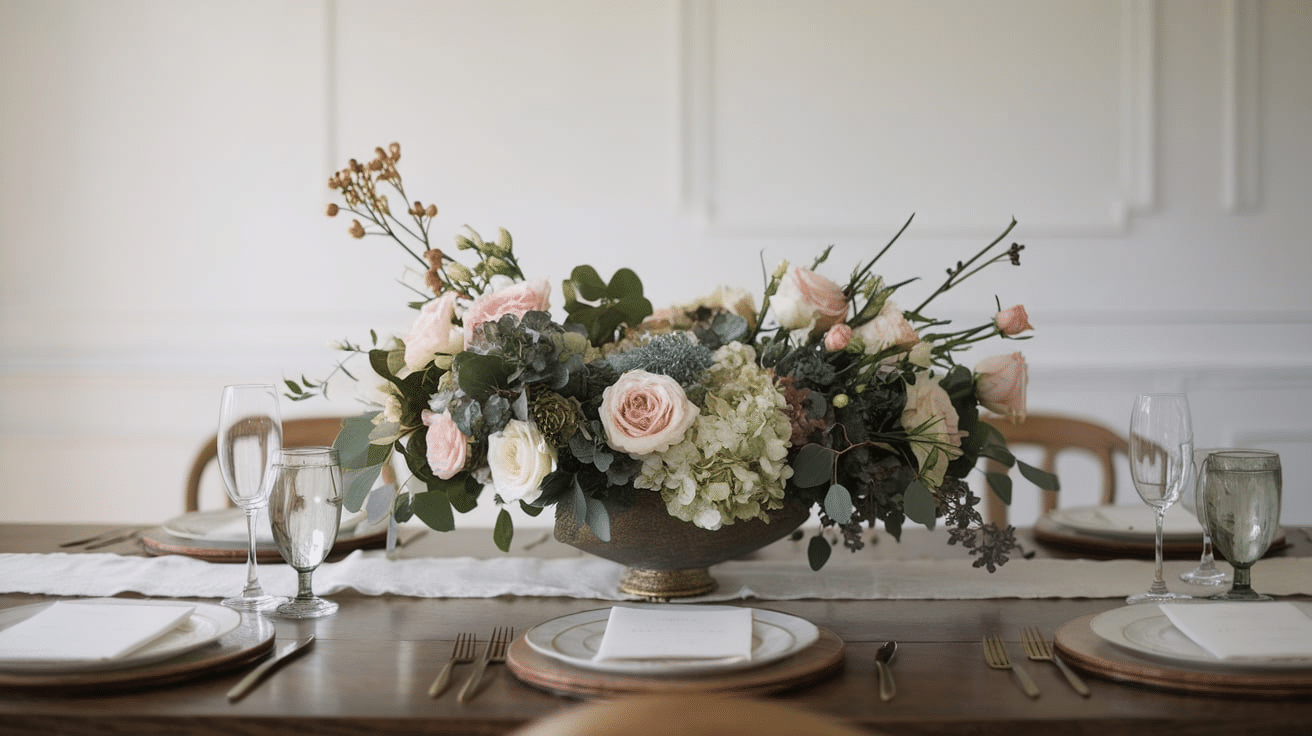
This style spreads flowers outward in a long, low shape, often used for table centerpieces. The vanishing point is usually at the base, where all the stems seem to connect.
How vanishing points help:
- Maintains a balanced, even spread of flowers.
- Helps guide the eye across the arrangement smoothly.
- Prevents the design from looking cluttered or uneven.
4. Vertical Arrangements
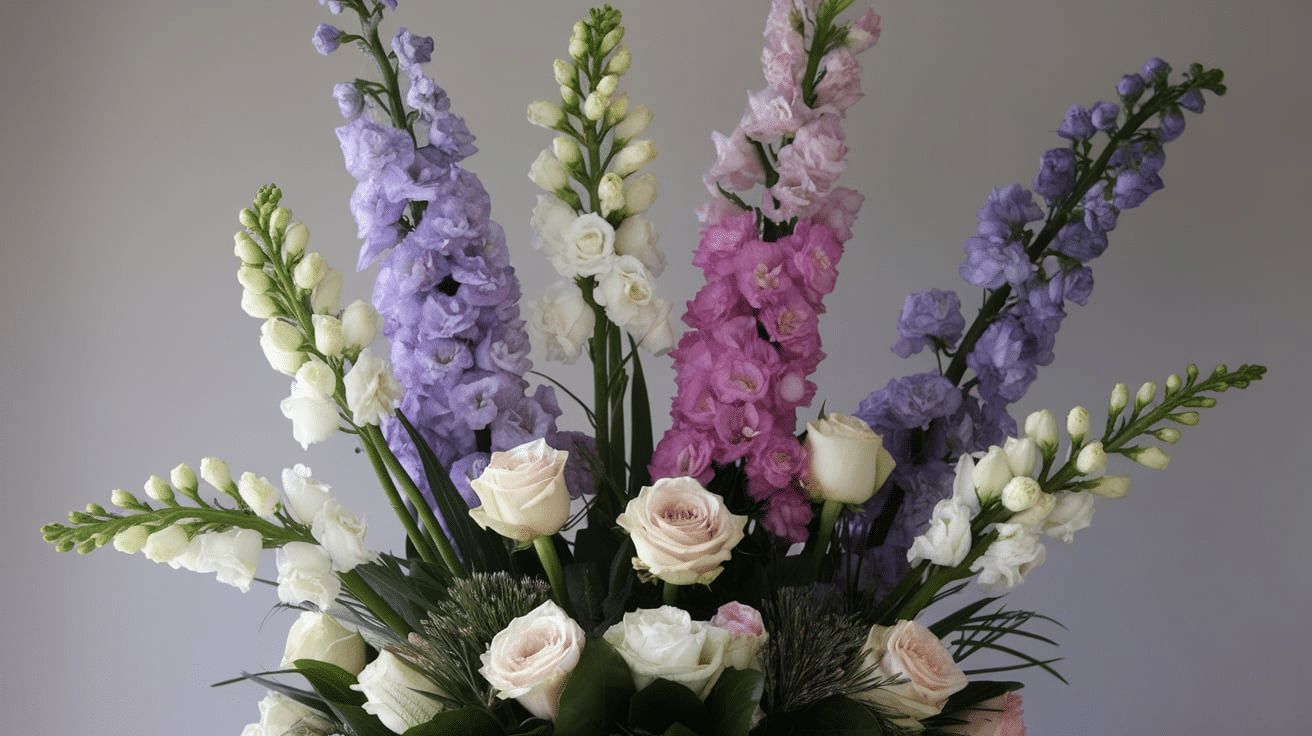
Tall, vertical floral designs focus on height and structure. The vanishing point is typically at the base, where all the stems come together before reaching upward.
How vanishing points help:
- Adds structure and balance to tall arrangements.
- Keeps the flowers looking cohesive instead of scattered.
- Draws attention to the height of the design.
No matter the style, using a vanishing point helps floral arrangements seem intentional and well-structured. It guides the eye, adds depth, and ensures that the flowers work together in a visually pleasing way. Whether you prefer classic symmetry or free-flowing designs, vanishing points help bring everything together.
Vanishing Point in Symmetrical vs. Asymmetrical Arrangements
A vanishing point is a useful tool in both symmetrical and asymmetrical floral arrangements. It helps create balance, structure, and direction in the design. Whether you want a classic, even look or a more natural, flowing style, understanding how to use a vanishing point can make a big difference.
1. Symmetrical Arrangements
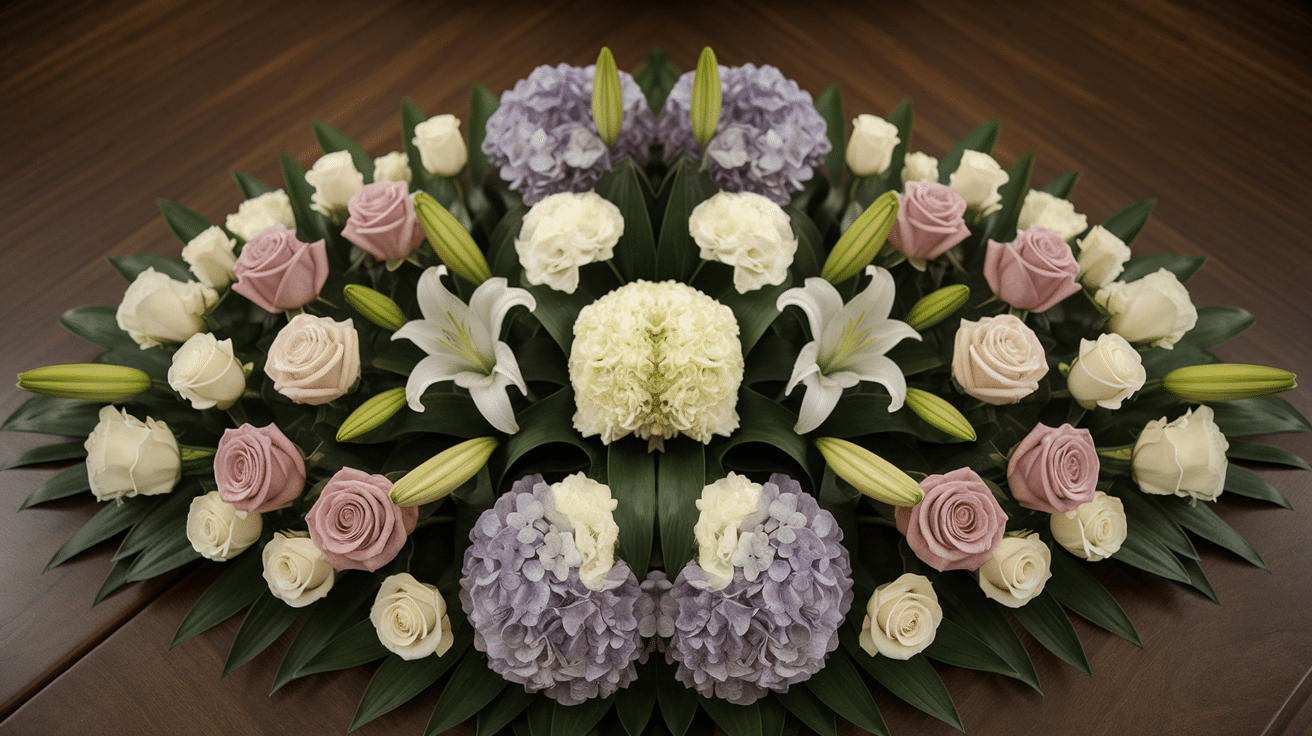
Symmetrical floral arrangements are balanced on both sides. If you split the design down the middle, both halves would look the same or very similar.
The vanishing point in a symmetrical arrangement is usually at the center, where all the stems seem to come together. This creates a structured, formal look often used for weddings, events, or traditional home decor.
How to Use a Vanishing Point in Symmetrical Arrangements:
- Place the tallest or most eye-catching flowers in the middle.
- Arrange shorter flowers and greenery evenly on both sides.
- Keep the stems directed toward a central base to maintain balance.
- Step back and check for evenness, adjusting as needed.
2. Asymmetrical Arrangements
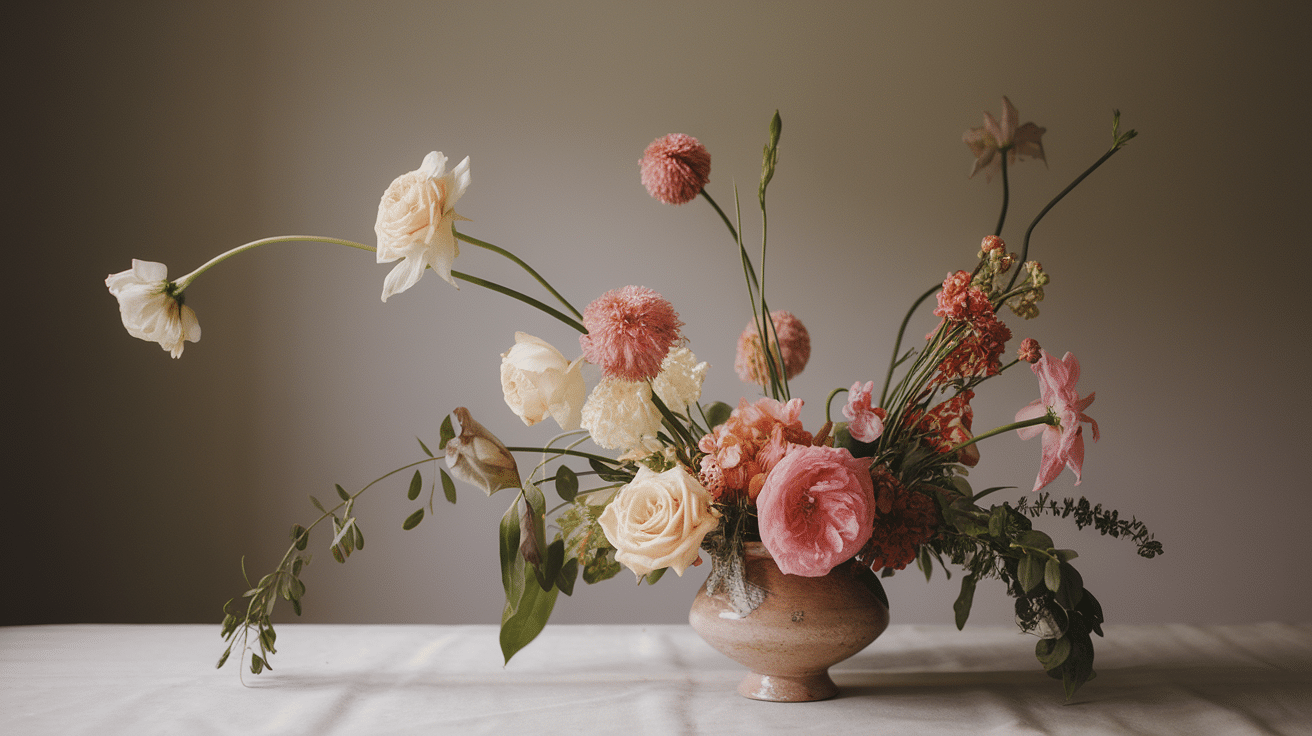
Asymmetrical floral arrangements feel more natural and free-flowing. Instead of being perfectly even on both sides, they have an intentional imbalance that makes them more dynamic.
The vanishing point in an asymmetrical design is usually off to one side, creating movement and visual interest.
How to Use a Vanishing Point in Asymmetrical Arrangements:
- Place the focal flowers slightly off-center to create a natural look.
- Let stems flow toward a vanishing point on one side instead of the middle.
- Use different heights and angles to add depth and movement.
- Balance the design with smaller flowers or greenery on the opposite side.
Both symmetrical and asymmetrical arrangements have their own beauty. Symmetry is great for formal events and classic designs, while asymmetry works well for casual, artistic, or modern looks. No matter which style you choose, using a vanishing point helps guide the eye and keeps the arrangement looking intentional instead of messy.
How Lighting Affects the Vanishing Point in Floral Arrangements
Lighting plays a big role in how a floral arrangement is viewed. It not only highlights colors and textures but also affects how the vanishing point is perceived. The way light falls on an arrangement can change its depth, balance, and overall impact.
1. Enhancing the Focal Point: A vanishing point helps guide the eye to a focal flower or area in the arrangement. Placing a light source above or slightly to the side of the focal point draws attention to it, making it appear more vibrant.
2. Creating Depth and Shadows: Shadows add depth, making an arrangement look more three-dimensional. When light comes from one side, it creates soft shadows that emphasize how stems and flowers flow toward the vanishing point.
3. Adjusting the Mood of the Arrangement: Bright lighting makes colors look bold and vibrant, making the vanishing point more pronounced. Soft or dim lighting creates a gentle, romantic feel, making the vanishing point blend in.
4. Avoiding Harsh Glares: Too much direct light can wash out the arrangement, making it harder to see depth and detail. Diffused lighting or indirect sources help maintain the structure of the design while keeping it visually appealing.
5. Playing with Light Direction: Top-down lighting keeps the vanishing point strong by illuminating the entire arrangement evenly.: Side lighting enhances texture and depth, and backlighting can create a glowing effect.
Lighting is just as important as flower placement when designing a floral arrangement. It affects how the vanishing point is seen and how the overall design feels. By adjusting light sources and angles, you can enhance depth, highlight focal points, and create a balanced and good-looking floral display.
Common Mistakes in Floral Arrangements
Creating a stylish floral arrangement takes practice, but avoiding common mistakes can make the process easier. Here are some of the most frequent errors and how to fix them.
1. Overcrowding the Flowers: Stuffing too many flowers together can make an arrangement look messy and overwhelming. Flowers need space to breathe so each bloom can stand out.
2. Ignoring a Focal Point: Without a clear focal point, the arrangement may look scattered and unstructured. The eye should be drawn to a main flower or area.
3. Uneven Stem Placement: If stems aren’t positioned correctly, the arrangement may look lopsided or awkward.
4. Using Flowers of the Same Height: An arrangement where all flowers are the same height can look flat and lifeless.
5. Poor Color Balance: Too many similar colors can make an arrangement look dull, while too many bold colors can be overwhelming.
6. Forgetting About Lighting
Lighting affects how an arrangement looks in different settings. Poor lighting can hide depth and make colors look dull.
By avoiding these mistakes, you can create floral designs that look balanced, professional, and visually appealing.
Conclusion
Creating a beautiful floral arrangement isn’t just about picking pretty flowers—it’s about balance, direction, and structure. A vanishing point helps bring everything together by guiding the eye and creating depth.
Focusing on a clear vanishing point can help avoid common mistakes like overcrowding, uneven stem placement, or a lack of depth. Using different heights, spacing flowers properly, and choosing a strong focal point all help create a natural flow. Lighting also plays a role in how an arrangement is viewed, so adjusting light sources can enhance its beauty.
With practice, you can use vanishing points to make floral arrangements that are polished and professional. If you’re designing for a special event or just decorating your home, this simple technique can make all the difference in how your flowers are displayed.
Frequently Asked Questions
How do I find the vanishing point in my arrangement?
Imagine a central spot at the base of your flowers where all stems seem to meet. In symmetrical designs, it’s in the center. In asymmetrical designs, it’s off to one side to create movement.
Can I have multiple vanishing points in one arrangement?
Yes, but it depends on the style. In complex or layered designs, there may be secondary vanishing points leading to the main focal area. However, keeping one clear vanishing point makes the arrangement look more cohesive.
Can beginners use vanishing points in floral design?
Absolutely! A vanishing point is an easy way to improve the structure and balance of any arrangement. Even simple bouquets look more polished when flowers follow a natural flow.


